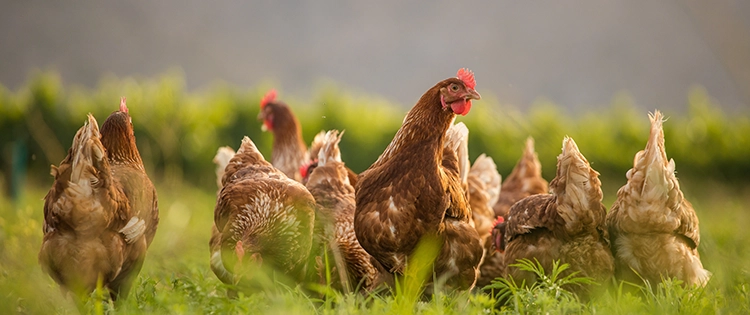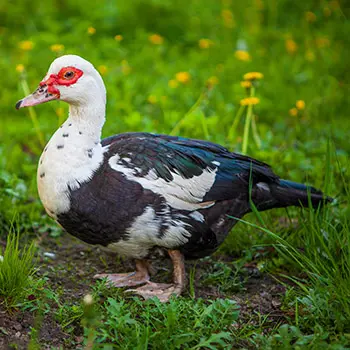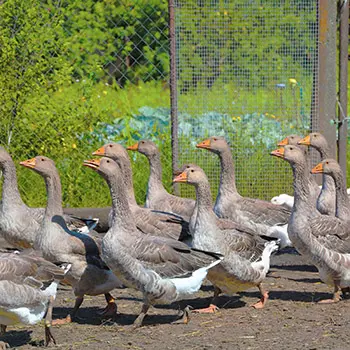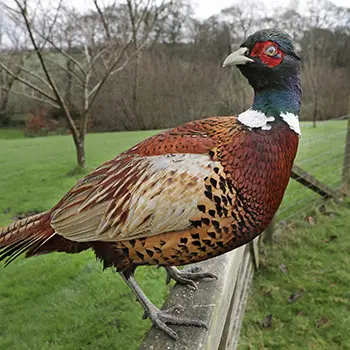Thinking of raising poultry like ducks, or quails for lower feed cost or egg varieties? Whatever the reason may be, exploring alternative options can be a learning curve for many, as different poultry types have distinct needs and requirements.
Let’s dive deep to know more about feeding requirements, size, and egg production, of various poultry and much more.
Here are 6 poultry options to raise as an alternative to chicken in your backyard:
Turkeys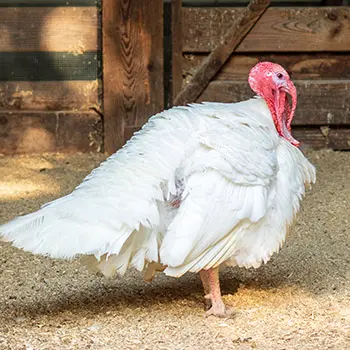
Turkeys are originally from North America, and every domestic turkey descended from the wild turkey (Meleagris gallopavo).
These birds are substantially larger than most chickens. A mature male turkey, or tom, weighs from 15 to 30 pounds, with female turkeys, called hens, weighing from 10 to 15 pounds.
Because of their size, turkeys need more room to roam. As for space, a good rule of thumb is to allow at least 10 square feet of interior space per turkey inside their coop and about 25 square feet per bird outside in their run.
Related: Why We Don’t Eat Turkey Eggs
They also munch through more food, needing a diet high in protein to support their growth. Young turkeys should start on a feed with about 28% protein, and as they grow, a 20% to 24% protein feed is suitable.
As far as laying eggs is concerned, turkeys are not considered to be as good a layer of eggs as chickens. A single turkey can lay only about 50 to 100 eggs in a year, which is very minimal compared with the 250-300 that a chicken could give in the same period of time.
Ducks
Ducks are another great poultry choice due to their size; they are between chickens and turkeys. Adults, depending on the breed, will generally weigh between 5 and 7 pounds.
Popular breeds include the Pekin, known for its meat, and the Khaki Campbell or Indian Runner, celebrated for their egg-laying abilities.
Ducks require less space than turkeys but a bit more than chickens. You want to allow for at least 4-6 square feet of space per duck in the coop, and about 15 square feet per duck in their run. While they do love water to swim in, it’s not necessary for their care.
Related: Read This Before Getting Ducks
Ducks start on a feed with about 20% protein, dropping to 16% as adults, consuming around 0.5 to 0.6 pounds of feed daily.
They are prolific layers, with some breeds laying up to 300 eggs per year. Duck eggs are larger and richer in flavor than chicken eggs and have a longer shelf life due to their thicker shells.
Geese
Geese are another poultry substitute that is much larger than chickens or ducks. A mature goose will weigh from 10 pounds to the extreme of possibly 20 pounds.
Popular breeds include the Embden and Toulouse, primarily raised for meat, and the Pilgrim and Sebastopol, which are also valued for their feathers and egg production.
The geese require more space compared to other birds since they are quite big. You may provide a minimum of 10 square feet per goose in the coop and about 25 to 30 square feet per goose in their outdoor run.
Related: Geese
Although they eat more overall, geese primarily graze on grass, which can help keep feed costs down. On average, an adult goose might need about 0.5 to 1 pound of supplemental feed each day.
As far as egg laying goes, geese are not a heavy producer of eggs, compared to chickens or ducks, normally producing 20 to 40 per annum.
Guinea fowl & Squabs
Guinea fowl and squabs are often raised as a sideline on farms around the world and are considered gourmet items. A mature guinea fowl will weigh about 3 to 4 pounds and is quite hardy, thriving in many climates.
Guinea fowl would require about 2 to 3 square feet per bird in the coop and, again, about 10 square feet per bird for the outdoor run.
They need a high-protein diet, particularly when young, with a starter feed containing about 24% protein recommended.
Guinea fowl normally lay between 60 to 100 eggs per year, which is rather less than that of chicken. Their eggs are smaller and have harder shells; thus, quite peculiar in the poultry world.
Quail
Quail are small game birds that offer a compact option for backyard poultry enthusiasts. They weigh just about 5 ounces on average, making them much smaller than other poultry options. Common breeds include the Northern Bobwhite, Cortunix, and the California Quail.
When it comes to space, quail is extremely space-efficient. Each bird needs just 1 square foot of space, though more space is always better to promote healthy living conditions.
Related: Quail Eggs vs Chicken Eggs
Quail requires a diet rich in protein, with starter feeds typically containing about 24% protein. If they have access to an outdoor run, they can naturally supplement their diet with insects and seeds, which enhances their nutrition.
Quail are very prolific birds that really start laying eggs at the age of 2 months and can produce up to one egg each day.
Pheasants
Pheasants offer an attractive and practical choice for those considering poultry options other than the usual due to their small size.
In size, they fall somewhere between quail and turkeys. When fully grown, pheasants weigh from 2 to 3 pounds.
Compared to quail, pheasants require more space but less than larger poultry. The recommended minimum space per pheasant has been suggested at least 10 square feet for roaming and thriving. This makes them suitable for a small to medium-sized setup.
Pheasants will require nutrient-rich feeds, mainly during the early stages of life. A starter feed should contain about 28 percent protein. As they get older, their feed’s protein value should be lowered to about 20 percent.
Additionally, pheasants produce fewer eggs than chickens—about 50-60 per year. Their eggs are larger than those of quail but smaller than chicken eggs, offering a unique size for culinary use.
You could raise other birds in your backyard, including turkeys, ducks, guinea fowl, quail, and pheasants. Each type of poultry has its own distinct advantage for raising. Some produce bigger eggs; others have better-tasting meat. A few even help control pests naturally.
Why not mix things up and add some variety to your coop? By exploring the alternative poultry options, you’ll have a backyard tailored to your space, preferences, and requirements.
Top 6 Best Egg-Laying Chicken Breeds
The Only Food That Grows Almost Faster Than You Can Eat It (Video)
Most Vicious Chicken Predators

